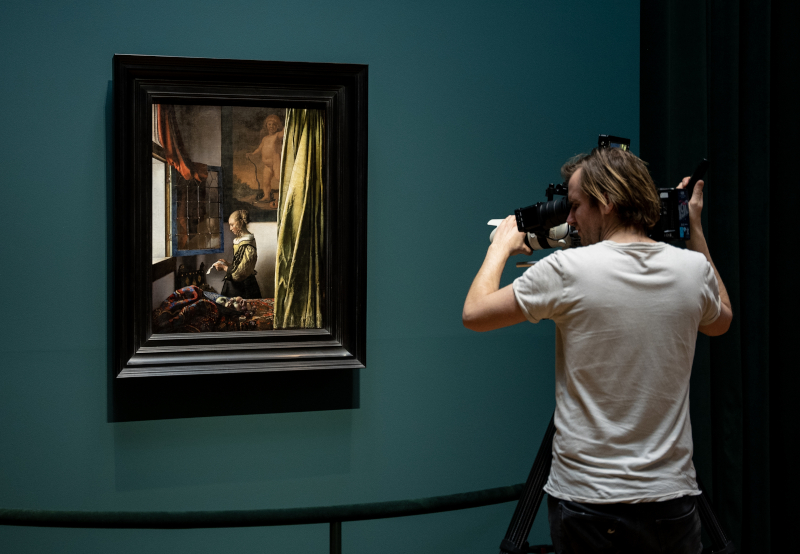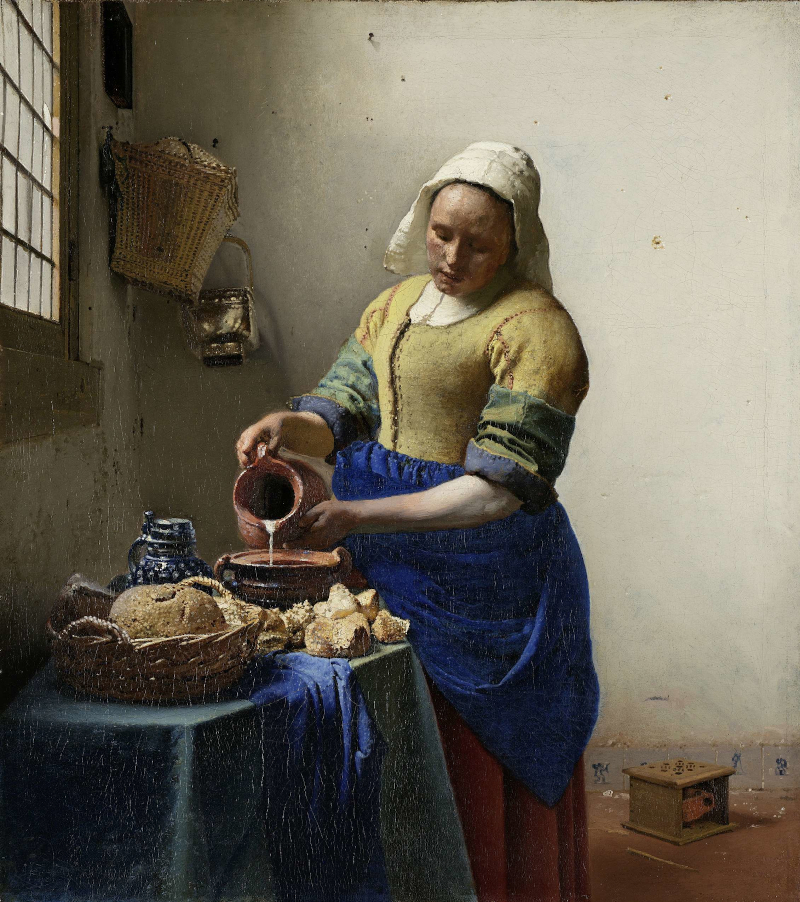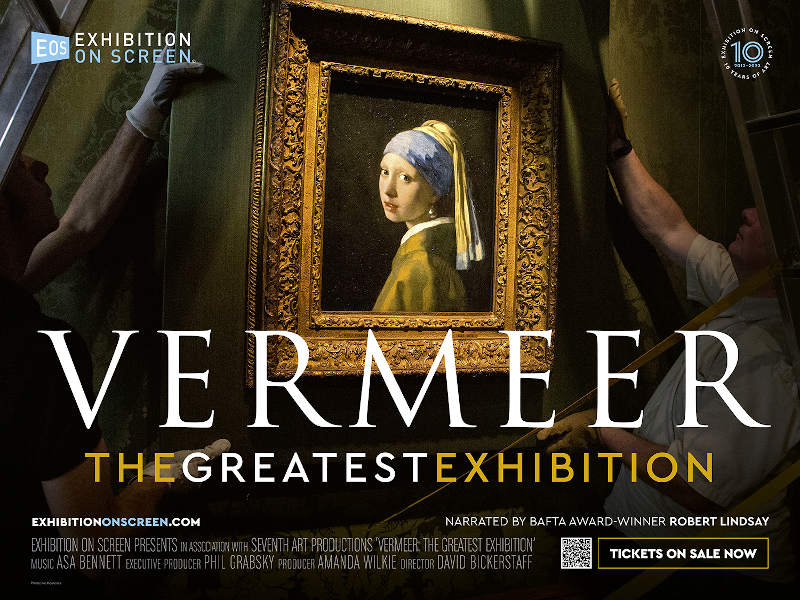Director – David Bickerstaff – 2023 – UK – Cert. PG – 90m
****
A tour around the Rijksmuseum’s current, sold out Closer to Johannes Vermeer exhibition, with comments from museum staff members and an art critic – out in cinemas both in the UK and around the world from Tuesday, April 18th
The latest instalment in producer Phil Grabsky’s excellent Exhibition On Screen series about art might be seen as something of a blockbuster: its subject is at once a famous artist and the current unprecedented, likely never to be repeated, comprehensive exhibition of that artist’s work. This allows the film to navigate the painter’s entire career in a chronological journey both through his images and, in a secondary, incidental journey, through the gallery itself. The latter journey is just there, visible but never described. Visitors tends to go to an art gallery to see its contents, or as in this case, a particular exhibition, not the gallery itself.
The blockbuster is the current exhibition at the Rijksmuseum in Amsterdam, entitled Closer To Johannes Vermeer, which runs from Friday, February 10th to Sunday, June 4th 2023 and is completely sold out. Vermeer (1632-1675) lived in the Dutch town of Delft, and in his active years as an artist painted only two or three pictures a year. Out of a total of 37 paintings still known to exist, including three of which the authorship is disputed, this exhibition gathers 28 under one roof. Unless you were able to book in advance, Exhibition On Screen’s film is currently the only way to see it.
The mostly chronological journey through the paintings displayed is narrated by Robert Lindsay and punctuated by comments from several art experts, some of them Rijksmuseum employees, talking to camera. As well as images of the paintings themselves, the comments help to open up Vermeer’s body of visual work and gives some ideas as to what he was about.

17th Century Holland was a small, urban country. Johannes’ father was an art dealer, so as a boy he would have been exposed to a wide variety of paintings.
The first of his paintings to which we are exposed here are local scenes marrying landscape and townscape such as his View Of Delft (1660-61), which strips what must have been the town’s bustling waterfront of its bustle to present a largely deserted scene with few people about, with the river placed between the viewer and the town. Although Vermeer is not really known for his landscapes, they have about them a sense of light falling on physical objects and of moments frozen in time. This one, like so many of his works, interacts with the viewer: in this case, we have to find the way to cross the river to get to the town.
Without dwelling on Vermeer’s religious background – he appears to have married into a Catholic family within a predominantly Protestant country – the Rijksmuseum’s Head Of Fine Arts Gregor J. M. Weber then traverses the exhibition’s first room’s early mythological and religious subjects including Diana And Her Nymphs (1655-56), Christ In The House Of Martha And Mary (1655) and Saint Praxedis (1655). The latter a saint who tended to the religious martyred, which art critic Rachel Campbell-Johnston suggests shows the strangeness of Vermeer in some of his subject matter choices, an intriguing remark which sadly isn’t followed up in the wider film.
After that, the religious element only really comes back in to play in a closing section covering Allegory Of The Catholic Faith (1670-74), Woman Holding A Balance (1662-4) and Woman With A Pearl Necklace (1662-4), where Campbell-Johnston outlines the Jesuit influence on Vermeer in terms of the Imaginative Contemplation practice of Ignatius and the way Vermeer’s paintings in general engage with all five of the viewer’s senses.
The images for which Vermeer is best-known are well represented, forming the bulk of the paintings shown and discussed. Their subjects tend to be women, often in small, interior, domestic spaces with a single light source (usually picture left). Sometimes objects in the foreground create a sense of distance between the viewer and what’s going on in the painting. The Rijksmuseum’s Head Of Paintings And Sculpture Pieter Roelofs describes the artist as the master of depicting everyday scenes and talks of his obsession with light (“the paint has dissolved”).

Discussing The Girl With A Pearl Earring (1664-7), Campbell-Johnston notes how, although he is clearly a consummate master of working in paint, there are no visible traces of brushstrokes and that the highlight on the pearl earring itself, arguably the most famous highlight in the History of Art, seems to just appear out of the image.
According to the Rijksmuseum’s General Director Taco Dibbits, the painting’s subject looks at us in a highly charged way. Yet, for Dibbits, the image is so simple: Vermeer captures the light on her skin, the directness of her face. The artist would have had to use a model to study the light, yet this is not a portrait of a specific person so much as of an idealised woman, wearing a headdress you’d be unlikely to see in real life.

The Rijksmuseum’s Paintings Conservator Anna Krekeler states of The Milkmaid (1658-59) that although you see this very quiet and calm painting, in the beginning it had really rough brushstrokes when he was setting up the composition. Her fellow Paintings Conservator Ige Verslype was involved in the restoration of Woman Reading A Letter In Blue (1662-4) and gives a fascinating account of what that work revealed, in terms of the artist building up the central figure on the canvas in terms of different layers of blue. For example, she notes a tiny, light blue haze underneath the darker blue back of the figure.

Vermeer married into wealth, but by 1672, the expansionist Holland was at war with practically every other European country and its economy collapsed, which for Vermeer meant there was no longer a market for which to sell his paintings. Time ran out for him. Money became a worry and he passed away within three years.
Being taken to look at these paintings one after another, a picture builds up of the artist’s small but nonetheless impressive body of work. Not much is known about Vermeer himself – there are no published letters or other verbal documentation – so the paintings really have to speak for themselves. Looking at them framed by both this exhibition and this documentary on it, it’s clear that they do. Although he painted pictures to be hung in the houses of those wealthy enough to afford them at the time – people who could afford servants as in Mistress And Maid, (1664-67) or their own piano-type musical instrument as in the two pictures of a woman standing and another sitting at a virginal (both 1670-72) – they still speak to us in today’s different social context.
A special mention should go to the quasi-ambient score by Asa Bennett which – rather like the largely undiscussed Rijksmuseum – does an excellent job counterpointing Vermeer’s images and the exploration of them, captivating without ever becoming intrusive. Should a DVD be released at some point, a separate music only audio track to showcase this would be most welcome.
With the current exhibition fully sold out, this documentary provides an excellent opportunity to visit and revisit those images.
Vermeer: The Greatest Exhibition is out in cinemas both in the UK and around the world from Tuesday, April 18th, check your local cinema for details.
Or to find a screening near you, click here.
Trailer:
